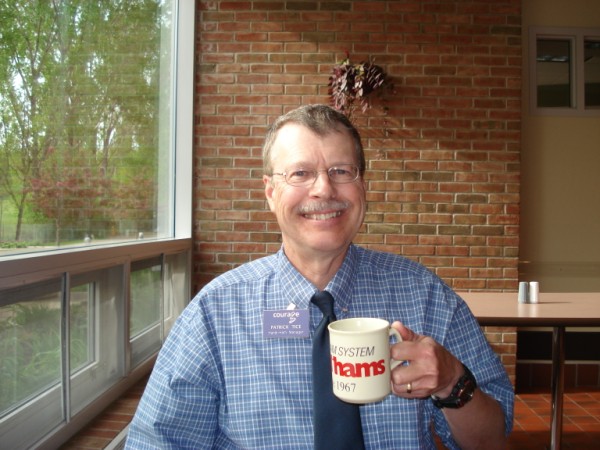
Heard on the air this morning:
"Nothing like an emergency to find out what works and what doesn't."
I had turned on my 2 meter rig, which was tuned to my club's repeater, and I soon learned that a widespread data outage had occurred in northeastern Minnesota when a fiber optic line was damaged. A bit of web research filled in the story a bit more. The outage began yesterday, January 26, when Qwest fiber optic cables were damaged at a site outside Duluth, Minnesota. A steam pipe in a manhole burst, and the hot gas damaged the fiber optic line. The stations I heard on the repeater were being ported into the Twin Cities via Echolink, thanks to our repeater's continuous connection to a wide area repeater network serving the area around western Lake Superior, the LSAC, or Lake Superior Amateur Coalition, system of linked repeaters. The stations were discussing what areas might still not have data service, even though it was now Wednesday, January 27. Of course a data outage meant that internet and 9-11 phone service were down. What was the response of a local TV station in the area? Why, to proudly announce that they posted outages and service status reports... on the internet!
By gluing my ear to the radio, I learned from the repeater conversation that the LSAC repeaters kept working throughout the emergency. A fire at an auto body shop happened during the outage, but had been put out safely.
Well, all of this puts me in mind of some basic truths about emergencies:
- You never know when they will happen. They are by their nature unexpected in a given moment, even though we understand intellectually that emergencies will happen.
- You never know what kind of damage may result or what other problems may be set in motion because of the original failure. There is often collateral damage extending outward along unpredictable paths.
- You never know exactly where they will happen. Oh, we may be able to say with some feeling of confidence that our basement ham shack will not flood from a burst dam, because we are on a hill and there is no dam for hundreds of miles, but just as we turn the key in the lock and leave for a week's vacation a water pipe bursts and we come home to a flood of our own.
- The media may not report the incident correctly.
The point is that we just never know. Understanding this does require some knowledge of probabilities, and that in turn helps us to manage the risk.
Take this communications outage, for example. Looking at the three basic truths, we see that it was completely unexpected, happening at a rather inconvenient time. It was the result of another infrastructure problem altogether, since the fiber optic cables would have been just fine if a steam pipe hadn't burst nearby. Thus, the steam pipe failure constituted the first emergency, and collateral damage to wide area communications quickly followed. There are steam pipes and cables running underground all around the world. Since the underground conduits place these two systems together, and probably also close to high voltage electrical distribution wiring, you can see that a catastrophic failure might well spread to other systems.
Who knew that a steam pipe failure would kill the internet? And 9-11 emergency service? And who could predict exactly where the conjunction of these various types of infrastructure would experience the failure?
Then there is the media. How many times have you listened to a story that has turned out ultimately to have been reported incorrectly? We know when the weatherman is wrong because we can tell when the rain falls and the sun shines, but what about when the media say things that are just not true? The reporters are well-meaning but often no not understand the technology or infrastructure that they are reporting about. This can lead to some rather silly stories making it out onto the air.
Where does amateur radio fit into the picture?
It is obvious to those of us in amateur radio: We provide a communications system that is redundant and separated from other communications infrastructure. There is nothing like redundancy to overcome the first three basic truths of when and where emergencies will happen and what collateral damage may result. Repeater systems can be located at different sites with overlapping coverage. The failure of internet connectivity will not bring down any individual repeater. A repeater that does go down will leave the others up and running. Individual operators will still have their own mobile and fixed stations. Compare that to a system where stream pipes, high voltage power lines, and fiber optic data cables all run in close proximity!
One problem area remains media coverage and perception of amateur radio. In story after story, I keep reading about the "old technology" of amateur radio being pressed into service in one emergency or another. To me, this is like saying that the telephone is old technology. Everyone knows that the phone system incorporates new, cutting-edge technology. The same is true of amateur radio, but somehow the media never seem to understand this. Furthermore, once a perception gets out there, it is hard to erase it. We know that amateur radio is cutting-edge in its new technology, and incorporates digital systems throughout. My suggestion is that you never miss an opportunity to let people know how modern and up to date ham radio is. We have to chip away at the perception that our activity is old-fashioned, a pastime of yesteryear.
Even so, we will be out there - waiting and ready for the next communications emergency.
For Handiham World, I'm...
Patrick Tice, wa0tda@arrl.net

